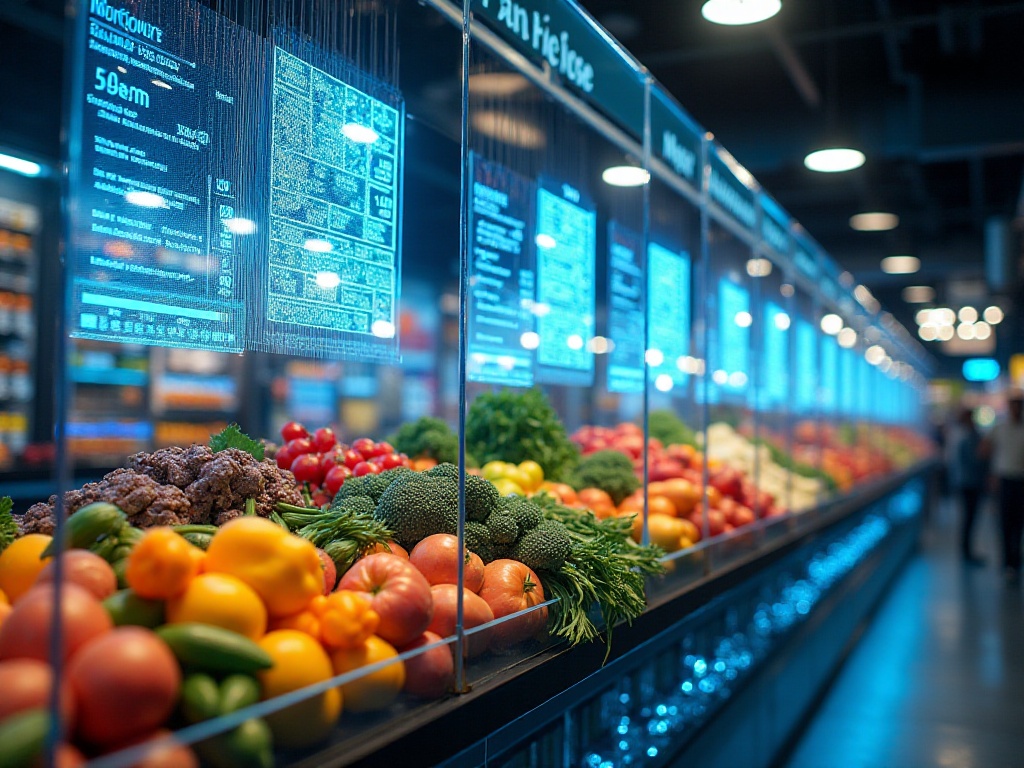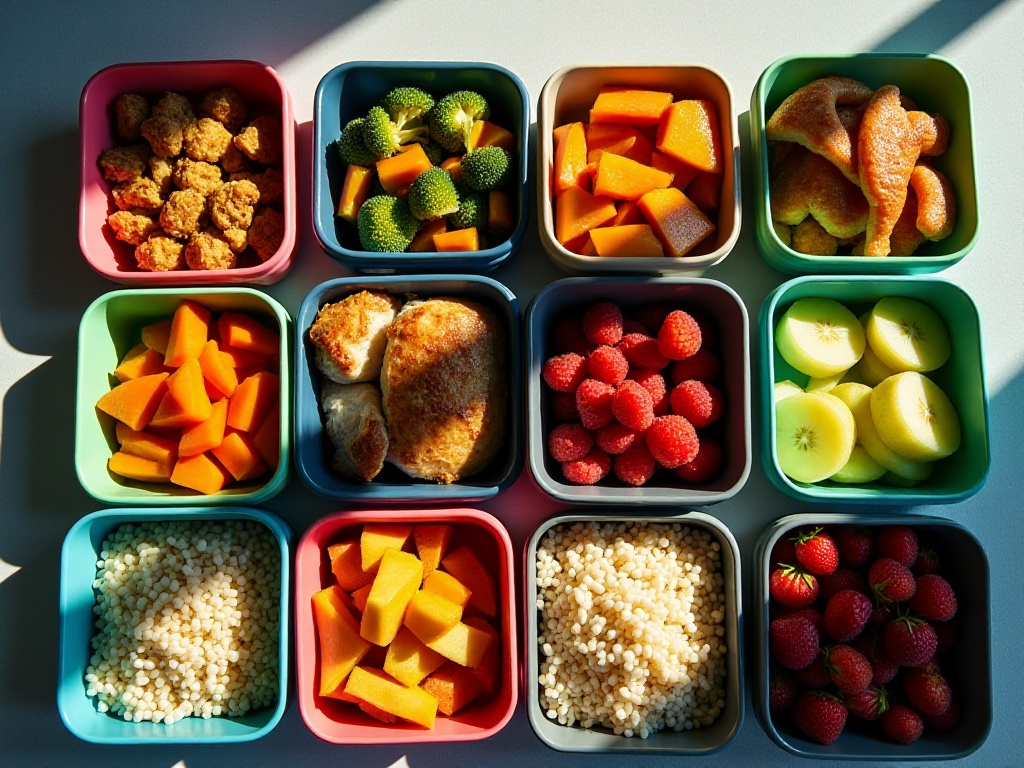
Introduction
Recently, I've noticed many friends discussing nutrition knowledge - some for fat loss and muscle gain, others for digestive health. Looking at various "healthy lifestyle check-ins" in my social media feeds, I can see everyone is really striving for a healthy lifestyle. To be honest, facing the overwhelming amount of nutrition information online can be quite confusing. As a nutrition blogger, I deeply understand people's confusion when creating nutrition plans. Today, I'd like to share how to create a nutrition plan that truly suits you.
Balanced Diet
When it comes to nutrition, many people's first thought is "eat less." However, the key isn't how much you eat, but what and how you eat. I remember when I first started studying nutrition, I was confused by the concept of three major nutrients. After years of learning and practice, I finally understand it now.
Carbohydrates are absolutely our body's main energy source. However, I want to especially remind everyone that choosing high-fiber whole grain foods is particularly important. For instance, instead of choosing refined white rice, try whole grains like brown rice or quinoa. I often substitute white rice with brown rice, and honestly, it was really uncomfortable at first - it felt especially tough to chew. But after persisting for about two weeks, I not only got used to the texture but also found my digestion had improved significantly. Now I've completely fallen in love with the slight nutty aroma of brown rice.
Speaking of whole grains, I recently discovered a particularly delicious combination. It's cooking brown rice and quinoa in a 2:1 ratio, then adding some mixed beans - it's not only nutritious but also tastes great. This combination is especially suitable for making lunch boxes, both healthy and economical when brought to the office. Now I cook a big batch in my rice cooker every Sunday, portion it into small containers for the refrigerator, and just heat it up when needed.
Protein intake is also a big topic. Nutrition studies show that protein should account for 10-35% of daily total calories. In practice, you can choose lean meat, fish, and legumes as protein sources. I've been particularly obsessed with making various dishes with chicken breast lately, such as chicken breast salad, boiled chicken breast, and pan-fried chicken breast. Honestly, chicken breast seemed very dry at first, but later I discovered the key is in the marinade and cooking method. My favorite way now is to cut the chicken breast into small pieces, marinate with minced garlic, ginger, cooking wine, and soy sauce for half an hour, then pan-fry with olive oil over low heat until golden brown, and finally sprinkle some black pepper - it's absolutely amazing!
Soy products are also a good source of protein. I particularly like tofu, which can be prepared in various ways. The simplest is mapo tofu, but you should choose firm tofu because it has higher protein content. There's also tofu skin, which can be rolled with various vegetables to make spring rolls - both healthy and delicious. However, I should remind everyone that while soy products are good, you shouldn't overdo it - one to two servings per day is enough.
When it comes to fat, many people get scared just hearing about it. Actually, there are good and bad fats - the key is choosing healthy fat sources. Olive oil, avocado, and nuts are all sources of quality fats. I eat a handful of nuts every day, which is both filling and nutritious. However, nut selection also requires attention - it's best to choose plain ones, and in moderation. I usually choose walnuts, almonds, and cashews, about 30-50 grams per day is enough.
I've also fallen in love with avocados recently. Although they're a bit expensive, their nutritional value is really high. My favorite way to eat them is avocado toast: slightly toast whole wheat bread, spread mashed avocado on top, sprinkle some sea salt and black pepper, add a few cherry tomatoes - it's the perfect breakfast combination.

Nutritional Supplements
After discussing the three major nutrients, let's talk about vitamins and minerals. Although these micronutrients are needed in small amounts, they're crucial for body health. The simplest way to supplement them is to eat the "rainbow" - eating vegetables and fruits of all colors. Red tomatoes, orange carrots, green spinach - each color represents different nutrients.
I've developed a habit now of having a glass of fruit and vegetable juice first thing after waking up. I put spinach, carrots, apple, and lemon in the juicer, then add some ginger for flavor - that's how I make a glass of nutrient-rich juice. Although it might not taste as sweet as store-bought juice, its nutritional value is definitely higher.
Speaking of vegetables, many people find it difficult to eat enough daily. I think the key is finding cooking methods that suit you. For example, many people think broccoli tastes bad, but if you lightly fry it with olive oil and sprinkle some minced garlic and salt, it tastes completely different. Spinach too - it can be made into dumpling filling or stir-fried with tofu, both very delicious.
Calcium and vitamin D supplementation shouldn't be ignored either. Besides dairy products like milk and yogurt, there are many fortified foods available now. However, I personally recommend natural ingredients, like having a glass of fresh milk for breakfast - both delicious and nutritious. I particularly enjoy drinking a glass of warm milk in the morning with a slice of whole wheat bread - it makes my whole day feel different.
If you can't drink milk, you can choose other calcium-rich foods like dried small fish, dried shrimp, or sesame. My mom particularly loves drinking black sesame soup every morning, and now her bone density test results are much better than her peers.
Omega-3 fatty acids are nutrients that many people easily overlook. Research shows you should eat omega-3 rich fish at least twice a week. Salmon and tuna are good choices. If you're like me and don't particularly like fish, you can choose alternatives like flaxseed and walnuts. I now often sprinkle some flaxseed on my breakfast oatmeal, which not only supplements omega-3 but also adds some special texture.

Eating Habits
At this point, I must emphasize the importance of eating habits. Even the best nutrition plan is hard to stick to without good eating habits as support. My suggestion is to start with small things and change gradually.
First is planning well. Spend an hour each week preparing ingredients, so you won't have to make do with whatever's available when you're busy. I usually prepare healthy snacks for the week on weekends, like portioning nuts into small packages and cutting fruits to store in containers. This way, I always have healthy snacks available even on busy workdays.
I also prepare some semi-finished products on weekends. For example, cutting and marinating chicken breast and freezing in portions, washing and cutting various vegetables and storing them by category - this saves a lot of time when cooking on weekdays. Remember to seal well with preservation bags or containers to maintain ingredient freshness.
Second is portion control. I suggest keeping a food diary so you can better understand what you're consuming each day. It might seem troublesome at first, but after persisting for a while, you'll find the changes this habit brings are very obvious. There are many diet tracking apps on phones now, which I find quite convenient to use.
I often take photos of everything I eat and review them in the evening. This not only monitors my diet but also helps me quickly notice if my nutrition is balanced. For example, if I notice insufficient vegetable intake for several consecutive days, I'll remind myself to eat more leafy greens the next day.
Finally, cook more at home. This way you can control both ingredient selection and seasoning amounts. I started trying to cook at least 5 meals per week since last year, and although it was uncomfortable at first, it's become enjoyable now. The biggest advantage of cooking at home is complete control over ingredient quality and cooking methods. For instance, I basically don't use MSG or chicken powder anymore, but rather natural seasonings like minced garlic, ginger, and scallions.

Special Needs
Everyone's situation is different, so nutrition plans should vary by individual. If you're an office worker with tight schedules, you need to find ways to make healthy eating more convenient. For example, prepare some ready-to-eat healthy snacks, choose takeout with high vegetable content, store some canned tuna and other convenient protein sources in the office.
I keep many healthy snacks in my office. For example, sugar-free nuts, boiled eggs, whole wheat crackers, etc. This way, when work pressure is high, I won't resort to high-sugar, high-fat snacks. I've found that eating these healthy snacks not only satisfies cravings but also maintains stable blood sugar levels, preventing afternoon drowsiness.
If ordering takeout, I suggest choosing stores that provide healthy meals. Many delivery platforms now have healthy meal categories and mark calorie content for each dish, making selection much easier. However, note that even with healthy meals, portion control is important - don't overeat just because it's healthy.
If you need to care for the whole family's diet, it requires even more attention. Set a good example for children and help them establish healthy eating habits from young. You can introduce new ingredients to children in interesting ways, like going to the supermarket together to select fruits and vegetables, involving them in simple cooking.
I have a friend who's particularly good at teaching her child about ingredients. She takes her child to the farmers' market on weekends, letting them choose their favorite vegetables and fruits. At home, she involves her child in simple cooking processes, like washing vegetables and picking string beans - safe tasks. Through this method, her child has not only learned to recognize various ingredients but also developed an interest in cooking.
For elderly nutrition, special attention is also needed. As age increases, digestive function gradually declines, so ingredients should be easy to digest and cooking methods should be light. My parents are particularly mindful of this now - dinner is basically easily digestible foods like steamed fish and soups.

Gut Health
Speaking of nutrition, we must mention gut health. Recent research increasingly proves that gut health is closely related to our overall health. I have personal experience with this - I used to frequently experience bloating and indigestion, but after adjusting my diet habits, these problems have greatly improved.
Probiotic foods are key to maintaining gut health. Quality yogurt and kefir are great choices. I must drink a glass of homemade kefir every morning for breakfast, and my digestive condition is much better than before. Speaking of kefir, you can actually make it at home at a low cost. I got some kefir grains from a friend, then culture them with milk daily - after 24 hours, you get fresh kefir.
Pickled vegetables are also a good source of probiotics. I recently learned to make Korean kimchi, and although it's a bit troublesome to make, it tastes especially good and can be eaten as a side dish - very appetizing. However, note that pickled vegetables are relatively high in salt, so daily consumption should be kept moderate.
Besides probiotics, prebiotics are also important. Foods like bananas and onions contain abundant prebiotics, which can help probiotics survive better in the gut. I often add onions to salads, which both enhances flavor and benefits health. I've found that raw onions might be a bit stimulating, but they become milder after a slight pickling or blanching.
Garlic is also a good source of prebiotics. I now use garlic in basically every meal, whether stir-frying or making sauces. Plus, garlic has antibacterial properties and helps boost immunity. If you find garlic's flavor too strong, you can choose black garlic - it's milder and has higher nutritional value.

Conclusion
After saying so much, the core is finding what works for you. Creating a nutrition plan isn't something achieved overnight - it needs continuous adjustment and optimization. The important thing is making healthy eating become a habit and enjoyment rather than a burden.
I now particularly enjoy my daily meals. Starting the day with a glass of homemade fruit and vegetable juice, bringing my prepared lunch box to work, enjoying healthy dinner with family in the evening. Although I occasionally indulge, overall, this lifestyle makes me feel particularly fulfilled and healthy.
If you also want to start changing your eating habits, try starting with the simplest things. For example, first replace white rice with brown rice, or eat one more serving of fruit daily. Take it slowly, and believe you can also find your own healthy eating way.
What thoughts and experiences do you have about creating nutrition plans? Welcome to share and discuss in the comments. I believe through our joint discussion, everyone can find the nutrition path that suits them best.
Next
Smart People's Nutrition Management Tips for Effortless Health and Fitness
A comprehensive guide to healthy eating and nutrition, covering balanced diet composition, healthy eating habits, and practical tips. Detailed information on choosing carbohydrates, proteins, healthy fats, and strategies for diverse fruit and vegetable intake
Done Being a Nutrition Novice? This Comprehensive Nutrition Guide Will Help You Eat Scientifically Starting Today
A comprehensive guide exploring core principles of balanced nutrition and healthy eating, including nutritional optimization advice, scientific dietary methods, and practical meal management tips to help readers establish healthy eating habits
A Nutritionist Tells You: This is How to Eat Healthy Without Too Much Hassle - I've Been Practicing for 3 Years
A comprehensive guide to healthy eating and nutrition improvement, covering dietary principles, habit formation, and practical tips on whole grain selection, fruit and vegetable combinations, and protein intake for a balanced diet
Next

Smart People's Nutrition Management Tips for Effortless Health and Fitness
A comprehensive guide to healthy eating and nutrition, covering balanced diet composition, healthy eating habits, and practical tips. Detailed information on choosing carbohydrates, proteins, healthy fats, and strategies for diverse fruit and vegetable intake

Done Being a Nutrition Novice? This Comprehensive Nutrition Guide Will Help You Eat Scientifically Starting Today
A comprehensive guide exploring core principles of balanced nutrition and healthy eating, including nutritional optimization advice, scientific dietary methods, and practical meal management tips to help readers establish healthy eating habits

A Nutritionist Tells You: This is How to Eat Healthy Without Too Much Hassle - I've Been Practicing for 3 Years
A comprehensive guide to healthy eating and nutrition improvement, covering dietary principles, habit formation, and practical tips on whole grain selection, fruit and vegetable combinations, and protein intake for a balanced diet
